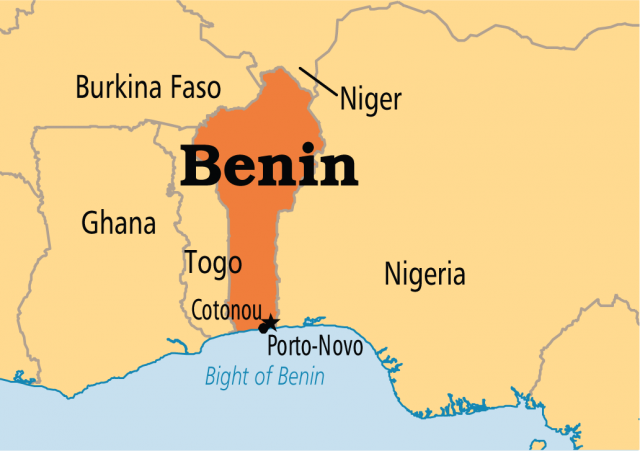Benin
Area 43,483 square mi (112,620 square km)
Population 10.60 million 2014
Capital Porto-Novo
Highest Point 2,158 ft (658 m)
Lowest Point 0 m
GDP $8.747 billion 2014
Primary Natural Resources oil, limestone, marble, timber.
BENIN IS LOCATED in West Africa and is bordered to the west by TOGO, to the north by NIGER and BURKINA FASO and to the east by NIGERIA. It stretches 435 mi (700 km) from the NIGER RIVER to the Gulf of Guinea. Behind the southern coastal zone, there are a series of interconnected lagoons and lakes. Behind this coastal region is found an area of fertile clay soils that is generally flat, crossed by the wide marsh, through which flows the Oueme River. Northwest Benin is a region of forested mountains (the Atacora, highest point 2,150 ft or 655 m), from which the Mekrou and Pendjari rivers flow northeast to the Niger River (which is part of the country's northern border). The northeast is a highland region containing little fertile soil and covered mostly with savanna.

POPULATION GROUPS
There are 42 ethnic groups in Benin, but its population is divided into four main ethnolinguistic groups: the Fon (in the south), the Yoruba (in the southeast near Nigeria), the Voltaic (in central and north Benin) and the Fulani (in the north). The country's official language is French. Almost three-quarters of the population follows traditional religious beliefs. Voodoo originated in Benin almost 350 years ago but was officially recognized only in 1996. About 15 percent of the Benin population is Muslim (mostly living in the north) and an equal number is Christian.
Benin's population is concentrated in the south and in rural areas. Most of the people engage in subsistence farming, with the main crops being cotton, corn, sorghum, cassava, beans, rice, peanuts, and palm oil. There is also an extensive freshwater fishing industry and a smaller sea fishing industry. Benin produces few manufactured goods, of which the largest are either processed agricultural goods (foods and beverages) or basic consumer items (textiles, footwear, ginned cotton). In 2002 the contribution of the agricultural sector to gross domestic product was 38 percent, while that of the industry was 15 percent and that of the service sector 47 percent.
Petroleum was discovered offshore of Porto-Novo in 1968, and in the 1990s was Benin's largest export. The other mineral resources found in the country (such as titanium, low-quality iron ore, ilmenite, and chromite) have not yet been extensively exploited. Apart from crude oil, the main exports are cotton, palm oil products, coffee and cocoa beans. The economy has been growing an average of 5 percent annually in the period 1991 to 2004, but rapid population growth has offset much of this increase. In 2001, 37 percent of the population was earning an income below the poverty line.